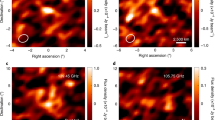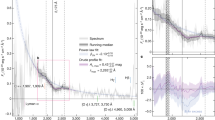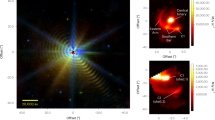Abstract
In the standard model of terrestrial planet formation, the first step in the process is for interstellar dust to coagulate within a protoplanetary disk surrounding a young star, forming large grains that settle towards the disk plane1. Interstellar grains of typical size ∼0.1 μm are expected to grow to millimetre- (sand), centimetre- (pebble) or even metre-sized (boulder) objects rather quickly2. Unfortunately, such evolved disks are hard to observe because the ratio of surface area to volume of their constituents is small. We readily detect dust around young objects known as ‘classical’ T Tauri stars, but there is little or no evidence of it in the slightly more evolved ‘weak-line’ systems3. Here we report observations of a 3-Myr-old star, which show that grains have grown to about millimetre size or larger in the terrestrial zone (within ∼3 au) of this star. The fortuitous geometry of the KH 15D binary star system allows us to infer that, when both stars are occulted by the surrounding disk, it appears as a nearly edge-on ring illuminated by one of the central binary components. This work complements the study of terrestrial zones of younger disks that have been recently resolved by interferometry4,5,6.
This is a preview of subscription content, access via your institution
Access options
Subscribe to this journal
Receive 51 print issues and online access
$199.00 per year
only $3.90 per issue
Buy this article
- Purchase on Springer Link
- Instant access to full article PDF
Prices may be subject to local taxes which are calculated during checkout




Similar content being viewed by others
References
Dominik, C., Blum, J., Cuzzi, J. N. & Wurm, G. in Protostars and Planets V (eds Reipurth, B., Jewitt, D. & Keil, K.) 783–800 (Univ. Arizona Press, Tucson, 2007)
Natta, A. et al. in Protostars and Planets V (eds Reipurth, B., Jewitt, D. & Keil, K.) 767–781 (Univ. Arizona Press, Tucson, 2007)
Wolk, S. J. & Walter, F. M. A search for protoplanetary disks around naked T Tauri stars. Astron. J. 111, 2066–2076 (1996)
van Boekel, R. et al. The building blocks of planets within the 'terrestrial' region of protoplanetary disks. Nature 432, 479–482 (2004)
Isella, A., Testi, L. & Natta, A. Large dust grains in the inner region of circumstellar disks. Astron. Astrophys. 451, 951–959 (2006)
Eisner, J. Water vapour and hydrogen in the terrestrial-planet-forming region of a protoplanetary disk. Nature 447, 562–564 (2007)
Winn, J. N. et al. The orbit and occultations of KH 15D. Astrophys. J. 644, 510–524 (2006)
Kearns, K. E. & Herbst, W. Additional periodic variables in NGC 2264. Astron. J. 116, 261–265 (1997)
Hamilton, C. M., Herbst, W., Shih, C. & Ferro, A. J. Eclipses by a circumstellar dust feature in the pre-main sequence star KH 15D. Astrophys. J. 554, L201–L204 (2001)
Herbst, W. et al. Fine structure in the circumstellar environment of a young, solar-like star: The unique eclipses of KH 15D. Publ. Astron. Soc. Pacif. 114, 1167–1172 (2002)
Chiang, E. I. & Murray-Clay, R. A. The circumbinary ring of KH 15D. Astrophys. J. 607, 913–920 (2004)
Winn, J. N., Holman, M. J., Johnson, J. A., Stanek, K. Z. & Garnavich, P. M. KH 15D: Gradual occultation of a pre-main sequence binary. Astrophys. J. 603, L45–L48 (2004)
Hamilton, C. M. et al. The disappearing act of KH 15D: Photometric results from 1995 to 2004. Astron. J. 130, 1896–1915 (2005)
Agol, E., Barth, A. J., Wolf, S. & Charbonneau, D. Spectropolarimetry and modeling of the eclipsing T Tauri star KH 15D. Astrophys J. 600, 781–788 (2004)
Boss, A. P. in Chondrules and the Protoplanetary Disk (eds Hewins, R. H., Jones, R. H. & Scott, E. R. D.) 257–263 (Cambridge Univ. Press, New York, 1996)
Artymowicz, P. & Lubow, S. H. Dynamics of binary-disk interaction. 1: Resonances and disk gap sizes. Astrophys. J. 421, 651–667 (1994)
Golimowski, D. A. et al. HST/ACS multiband coronagraphic imaging of the debris disk around Beta Pictoris. Astron. J. 131, 3109–3130 (2006)
Hamilton, C. M., Herbst, W., Mundt, R., Bailer-Jones, C. A. L. & Johns-Krull, C. M. Natural coronagraphic observations of the eclipsing T Tauri system KH 15D: Evidence of accretion and bipolar outflow in a weak-line T Tauri star. Astrophys. J. 591, L45–L48 (2004)
Tokunaga, A. T. et al. H2 emission nebulosity associated with KH 15D. Astrophys. J. 601, L91–L94 (2004)
Johnson, J. A. & Winn, J. N. The history of the mysterious eclipses of KH 15D: Asiago Observatory, 1967–1982. Astron. J. 127, 2344–2351 (2004)
Johnson, J. A. et al. The history of the mysterious eclipses of KH 15D. II. Asiago, Kiso, Kitt Peak, Mount Wilson, Palomar, Tautenburg, and Rozhen Observatories, 1954–1997. Astron. J. 129, 1978–1984 (2005)
Johnson, J. A., Marcy, G. W., Hamilton, C. M., Herbst, W. & Johns-Krull, C. M. KH 15D: A spectroscopic binary. Astron. J. 128, 1265–1272 (2004)
Kusakabe, N. et al. Near-infrared photometric monitoring of the pre-main sequence object KH 15D. Astrophys. J. 632, L139–L142 (2005)
Burbine, T. H. & Binzel, R. P. in Asteroids, Comets, Meteors 1993 (eds Milani, A., Di Martino, M. & Cellino, A.) 255–270 (Proc. IAU Symp. 160, Kluwer, Dordrecht, 1994)
Acknowledgements
This material is based on work supported by the US National Aeronautics and Space Administration (NASA) through the Origins of Solar Systems programme. Some of the data presented here were obtained at the W. M. Keck Observatory from telescope time allocated to NASA through the agency’s scientific partnership with the California Institute of Technology and the University of California. The Observatory was made possible by the financial support of the W. M. Keck Foundation. We appreciate comments from E. Chiang, M. Gilmore, J. Greenwood and E. Jensen.
Author information
Authors and Affiliations
Corresponding author
Supplementary information
Supplementary Information
This file contains three sections of supplementary information and a Supplementary Figure 1 with Legend. Section 1 explains our calculation of the variation of optical depth with elevation for star A and includes a figure. Section 2 explains the model light curve. Section 3 is a derivation of the expression for optical depth. (PDF 94 kb)
Rights and permissions
About this article
Cite this article
Herbst, W., Hamilton, C., LeDuc, K. et al. Reflected light from sand grains in the terrestrial zone of a protoplanetary disk. Nature 452, 194–197 (2008). https://doi.org/10.1038/nature06671
Received:
Accepted:
Issue Date:
DOI: https://doi.org/10.1038/nature06671
Comments
By submitting a comment you agree to abide by our Terms and Community Guidelines. If you find something abusive or that does not comply with our terms or guidelines please flag it as inappropriate.



